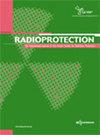Patient dose assessment in Computed Tomography in a Moroccan imaging department
IF 1.4
4区 医学
Q4 ENVIRONMENTAL SCIENCES
引用次数: 0
Abstract
Facing the inflation of the number of irradiating radiological examinations, particularly in Computed Tomography (CT), several countries in the world have resorted to diagnostic reference levels (DRLs), below which dosimetric values must be kept or else corrective actions will be infligated. In Morocco, in the absence of national diagnostic reference levels, we proposed to evaluate the professional practice in CT by recording the radiation doses values delivered to adult patients and comparing the 75th percentile values of the dosimetric indicators (CTDIvol and DLP) per acquisition to the international published values of DRLs, in order to judge the need for optimization of CT examination protocols. The 75th percentile values in terms of CTDIvol for head, chest, abdomen-pelvis, chest- abdomen-pelvis, and lumbar examinations were respectively 57.7, 11.1, 11.3, 11.6 and 20 mGy. In terms of DLP, the 75th percentile values were 1250.4, 392.2, 517.1, 833.27 and 707.37 mGy.cm, for the mentioned type of examinations. These results prompt us to make corrections to the used protocols and to ensure a more rigorous follow-up of the radiation protection principles with particular attention to the principle of dose optimization in order to establish a good practice in CT.摩洛哥影像科计算机断层扫描病人剂量评估
面对辐照放射检查,特别是计算机断层扫描(CT)数量的膨胀,世界上一些国家采用了诊断参考水平(drl),必须保持低于该水平的剂量学值,否则将采取纠正措施。在摩洛哥,由于缺乏国家诊断参考水平,我们建议通过记录提供给成年患者的辐射剂量值,并将每次获取的剂量学指标(CTDIvol和DLP)的第75百分位值与国际公布的drl值进行比较,来评估CT的专业实践,以判断是否需要优化CT检查方案。头部、胸部、腹部-骨盆、胸腹-骨盆和腰椎检查CTDIvol的第75百分位值分别为57.7、11.1、11.3、11.6和20 mGy。DLP的第75百分位值分别为1250.4、392.2、517.1、833.27和707.37 mGy。Cm,用于上述类型的检查。这些结果促使我们对所使用的方案进行修正,并确保对辐射防护原则进行更严格的随访,特别注意剂量优化原则,以便在CT中建立良好的做法。
本文章由计算机程序翻译,如有差异,请以英文原文为准。
求助全文
约1分钟内获得全文
求助全文
来源期刊

Radioprotection
ENVIRONMENTAL SCIENCES-PUBLIC, ENVIRONMENTAL & OCCUPATIONAL HEALTH
CiteScore
3.30
自引率
54.50%
发文量
35
审稿时长
>12 weeks
期刊介绍:
Radioprotection publishes articles on all aspects of radiological protection, including non-ionising as well as ionising radiations. Fields of interest range from research, development and theory to operational matters, education and training. The very wide spectrum of its topics includes (theoretical and practical aspects): dosimetry, instrument development, specialized measuring techniques, epidemiology, biological effects (in vivo and in vitro) and risk and environmental impact assessments.
 求助内容:
求助内容: 应助结果提醒方式:
应助结果提醒方式:


